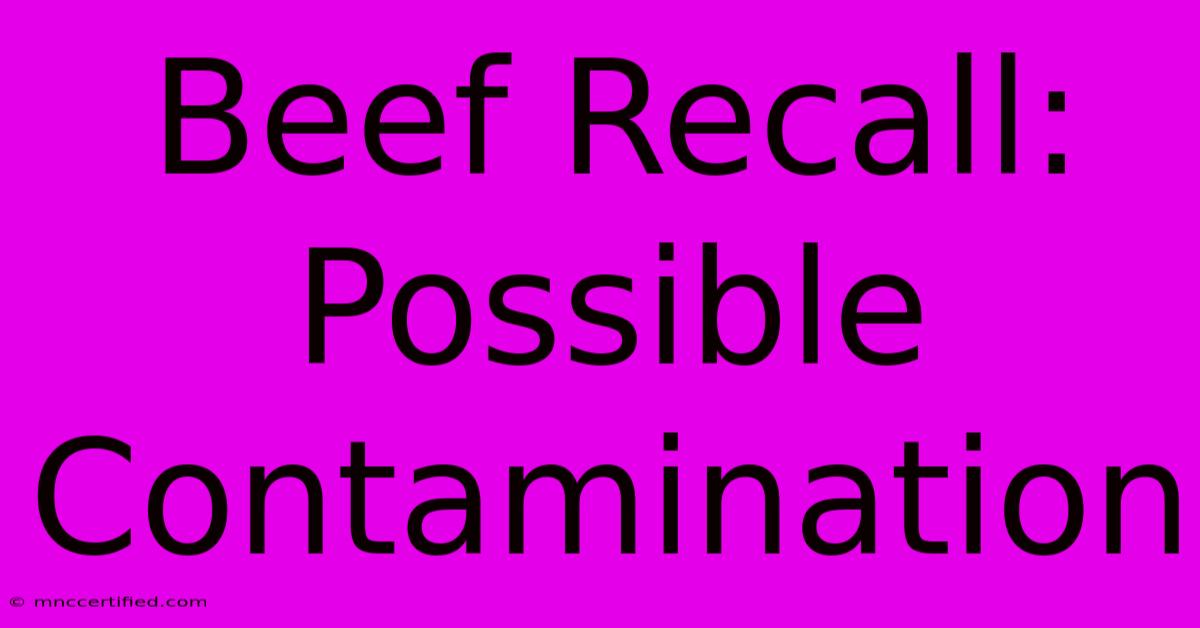Beef Recall: Possible Contamination

Table of Contents
Beef Recall: Possible Contamination – What You Need to Know
Recent reports of beef contamination have understandably caused concern among consumers. Understanding the specifics of a beef recall, how to identify affected products, and steps to take to ensure your safety is crucial. This article will provide comprehensive information on navigating beef recalls and minimizing potential health risks.
Understanding Beef Recalls: Causes and Consequences
Beef recalls are issued by government agencies like the USDA's Food Safety and Inspection Service (FSIS) when there's a reasonable probability that the product is contaminated and could cause illness. Several factors can lead to a recall:
Common Contamination Sources:
- E. coli: A common source of foodborne illness, E. coli contamination can result in severe diarrhea, vomiting, and abdominal cramps. Certain strains can be life-threatening.
- Salmonella: Another significant bacteria causing food poisoning, salmonella can lead to similar symptoms as E. coli, ranging from mild to severe.
- Listeria monocytogenes: This bacteria can be particularly dangerous for pregnant women, the elderly, and those with weakened immune systems. Listeriosis, the infection caused by Listeria, can be fatal.
- Foreign material: This includes anything unexpected found in the beef, such as bone fragments, plastic, or metal. While not always causing illness directly, it presents a choking hazard and can cause injury.
Consequences of Consuming Contaminated Beef:
The consequences of consuming contaminated beef range from mild discomfort to serious illness, hospitalization, and in rare cases, death. Symptoms usually appear within hours or days of consumption and vary depending on the contaminant and the individual's immune system. If you suspect you've consumed contaminated beef and are experiencing symptoms, seek medical attention immediately.
How to Identify Recalled Beef Products
The FSIS utilizes a comprehensive recall system. When a recall is issued, they provide crucial information to help consumers identify affected products:
- Brand name: The specific brand of beef involved in the recall will be clearly stated.
- Establishment number: This number is located inside the USDA inspection mark and helps trace the product back to its origin.
- Production date: The specific dates the affected beef was produced are vital for identification.
- Product code: Unique codes assigned to specific batches of beef will be listed.
- Packaging description: This includes the type of packaging (e.g., tray, vacuum-sealed) and weight.
Check the FSIS website (fsis.usda.gov) regularly for updates on current recalls. The site provides detailed information, including images of recalled products. You can also sign up for email alerts to be notified immediately about new recalls.
Steps to Take During a Beef Recall
If you suspect you have recalled beef in your refrigerator:
- Do not consume the product. Even if it looks and smells fine, it could still be contaminated.
- Check the product's label carefully. Compare the details on the label with the information provided in the recall announcement.
- Discard the product immediately. Properly dispose of the beef in a sealed bag to prevent cross-contamination.
- Contact the retailer. If you purchased the beef from a store, contact them to inform them of the recalled product and inquire about a refund or replacement.
- Monitor your health. Pay close attention to any symptoms of food poisoning and seek medical attention if necessary.
Preventing Future Contamination: Safe Handling Practices
Practicing safe food handling techniques is vital in minimizing the risk of contamination:
- Cook beef thoroughly. Use a meat thermometer to ensure the internal temperature reaches a safe level (160°F or 71°C).
- Wash hands thoroughly: Wash hands before and after handling raw beef.
- Clean surfaces: Clean and sanitize all surfaces that have come into contact with raw beef.
- Store beef properly: Store raw beef at a safe temperature (below 40°F or 4°C).
- Avoid cross-contamination: Prevent raw beef from coming into contact with other foods.
By staying informed about beef recalls and adopting safe handling practices, you can significantly reduce your risk of foodborne illness. Remember, your health is paramount. If you have any doubts, err on the side of caution and discard the beef. Staying vigilant and informed is the best way to protect yourself and your family.

Thank you for visiting our website wich cover about Beef Recall: Possible Contamination. We hope the information provided has been useful to you. Feel free to contact us if you have any questions or need further assistance. See you next time and dont miss to bookmark.
Featured Posts
-
Insurance For Historic Buildings
Nov 22, 2024
-
Lp Thompson Insurance Hammond Ny
Nov 22, 2024
-
Another Eruption Icelands Reykjanes Volcano
Nov 22, 2024
-
Arsenal Edges Juventus 1 0 Ucl Recap
Nov 22, 2024
-
Mar A Lago Trumps New Intel Briefings
Nov 22, 2024